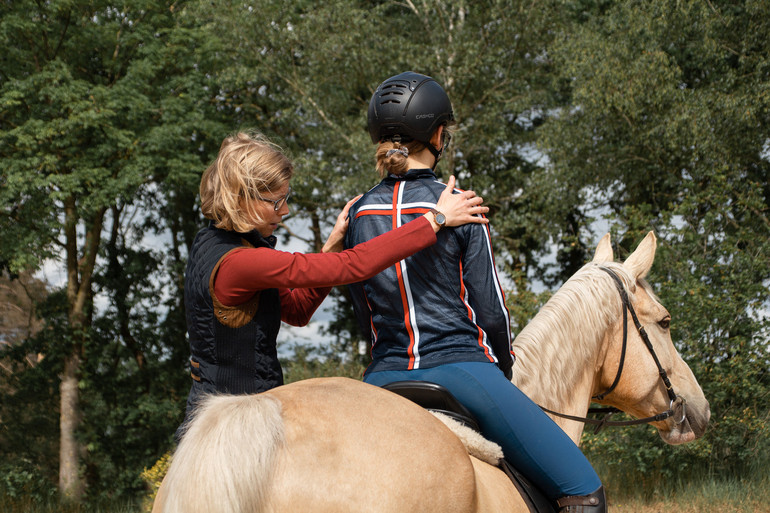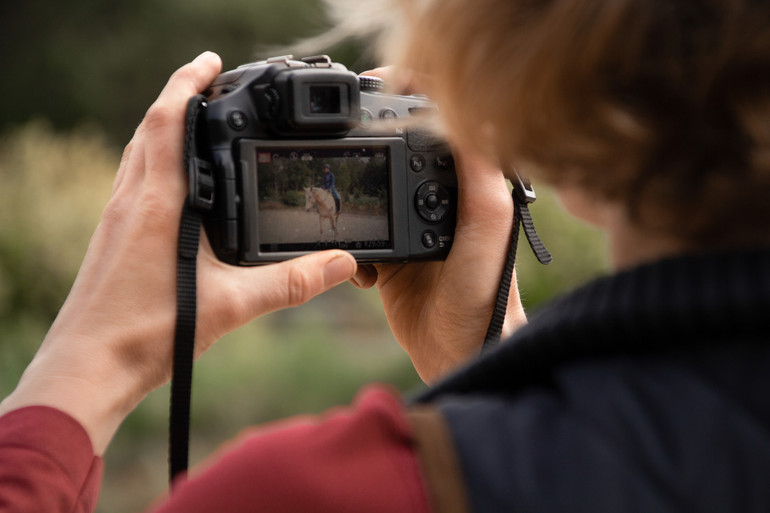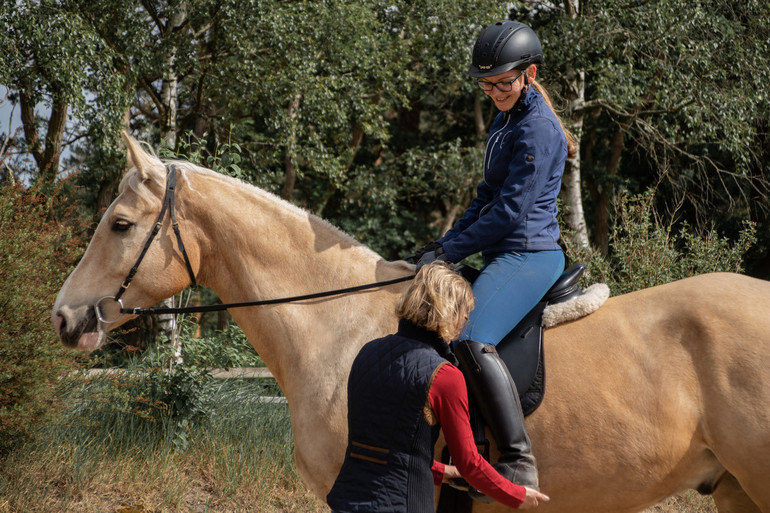Text © World of Showjumping
Did you ever consider how your own movement patterns have an impact on the health and mobility of your horse? “Over time, it has become obvious to me how horses simply mirror their riders’ problems,” Imke Schlömer – an equine osteopath and physiotherapist – tells World of Showjumping.
The 40-year-old German has treated all kinds of horses from hobby level to international showjumpers, but has since 2011 shifted her focus to assist riders with their own functional training. “To me, it made more sense to focus on the problems that occur in the saddle, rather than keeping on treating the horses," Imke says.
Understanding the horses’ movements
“If a rider has a problem in their sacroiliac joint on the left, you can just wait for the horse to develop the same issue,” Imke begins. “Seeing how the horses actually mirror the issues of their riders, I got frustrated by repeating the same treatments time after time on the horses, only to see their issues reappear. Therefore, it made more sense to take a closer look at the riders. I started to focus on treating riders on the ground and tried to develop a concept that would help me find answers. I looked into many different systems from connected riding to posture training but in the end it was Dr. Josef Kastner– who is a sports scientist – that really gave me the answers I needed. He has a very scientific view, which in my opinion is only logical. His idea is that we first must understand the horses’ movements, and, based on that, develop our own concept on how to best adapt to those movements so that we disturb the horses as little as possible.”
One of the most common issues Imke sees is horses resisting their riders’ aids. “Horses having a tight back and a very strong lower neck, going against the rider’s hand, not bending, having problems to keep the rhythm, as well as lameness caused by the rider’s influence, are all common issues,” she explains. “Every one of us has a preference on movement, starting from being left- or right-handed. Sometimes we have old injuries that have affected our movement patterns as well and all these influences together create a preferred way of moving which always depends on the individual. As an example, for me it is easier to rotate my body to the left rather than to the right, and therefore riding a left turn is easier for me than riding a right turn. Naturally horses can also have issues, but most of the time we as riders just use our own preferences to move, and what we think is a problem in the horse, is actually a problem that relates to us as riders. Balance issues are common as well; often riders are not balanced enough and need the horses to help them.”
Horses compensate for our issues
“With a new client, I first try to understand their preferences,” she continues. “I like to watch them moving on the ground, as well as on the horse. When you know what to look for, it is quite easy to understand their strengths and weaknesses. My goal is to work on the symmetry – which is really important – as well as making sure the client actually understands their problem. Working on their awareness of the issue is key; the rider can only change once he or she knows what is wrong. With a video, it is easy to get them on my side: I like to work with a visual like that, because it helps a lot in explaining the issues. If I see a problem, I take a short video with my phone and show it to the rider – and normally that is enough to convince. I am lucky we live in these times and that I can use these technologies, that helps a lot in opening the riders’ minds.”
“When I have a rider standing on a flat surface, I have some very simple exercises which immediately illustrate to them if they have a difference between left and right,” Imke continues. “The horses compensate so much, that riders might not feel how crooked they are when they are sitting on a moving, flexible horse. On the ground, a rider is alone and then their crookedness – or any other issue – is easier to detect.”
Be aware of your own movement patterns
A practical example of how a rider’s movement in the saddle affects the horse are canter-trot transitions. “What I am looking at in this moment is the lateral view; we have the movement up and down, forwards and backwards,” Imke explains. “While the movement is three-dimensional, we are only focusing on two dimensions and try to understand how the pelvis has to move to be as perfectly in sync with the horses’ movements as possible. In trot, the back of the horse in the swinging phase moves up and forward, and in the landing phase down and backwards. We need to follow this and there is only one way to do so and that is to open the way for the horses’ backs; for the swinging phase we have to bend our lumbar spine so that our seat bones can also move up and forward, and in the landing phase we come back to the neutral position of the lumbar spine, so that the seat bones are at their deepest point. I see many riders who like to swing from the neutral position to the hollow back, but then the seat bone moves up and backwards – that is the opposite of what the horse’s back is doing in trot. Riders need good, rhythmically working abdominal muscles, because only those muscles can flex your lumbar spine. In canter, it is the other way around; we start in a more or less hollow back position, bring the pelvis forward to the neutral position and depending on the horse and its gaits, maybe even a bit more forward – but the actual movement is the opposite as in trot."
"When you look at the attached video, pay attention to where the seat bone moves to when the horse’s feet have contact with the ground: In trot, the seat bone moves backwards in the landing phase, and in canter it moves forward. That is the difference, and you have to change the direction of the swing on your pelvis when you do transitions.”
There are simple exercises you can do both at home as well as on a horse to improve the awareness of your own movement patterns. “At home, you can improve your position in sitting trot and canter by imitating the movement in a standing position,” Imke tells. “You can stand in your living room and train. First, you need to find the best angle for your knees, because the pelvis in only free to move when the hip joint has the right angle. Standing on straight legs, it is almost impossible to move your pelvis, so you need lightly bended knees to have a full range of movement for your pelvis. Changing between flexing your lumbar spine – using your abdominal muscles – and coming back to the middle position is what happens in trot, and then for canter it is the opposite; start in a lightly hollow back position and bring the pelvis forward to the middle position.”
“When sitting on a horse, start in walk, by making sure that your pelvis moves three-dimensionally,” Imke continues. “Many riders like to lean backwards already in walk and starting like that easily leads to a one-dimensional movement – only back and forth – of the pelvis. When the upper body is really straight, you immediately feel the three-dimensional aspect of the movement; left and right, up and down of the seat bones and left and right forward swing of the pelvic bones. The precondition for the right pelvic movement is that the upper body is straight – otherwise the abdominal muscles start to work dominantly and inhibit all the other muscles around the trunk, making three-dimensional well-coordinated movement impossible. That is why it is so important to have the upper body straight. Observing the pelvic movement in walk, leaning back and forward with the upper body, you will realize which position helps the pelvis be free so that you have more awareness of your own seat. We always have one stronger leg and we like to have one knee tighter to the saddle and naturally on that side, the pelvis cannot be as flexible as on the other.”
Moving with the horse
The correct movement in the saddle can sometimes be found by accident. “When we learn to ride, we are told how to sit and the normal advice is static; bring your shoulders back, take your hands down,” Imke explains. “Therefore, we tend to have a very static idea of how to ride but the question is, do we sit still for the looks or for the horse? Sitting still for the horse means to be with the horse in their movement; in walk their neck and head moves, and if you have your hands frozen still and don’t follow the head, you end up pulling, but when you are flexible in your shoulders and elbows, swinging with the movement of the horse, you have a stable connection to the mouth and that in the end is softer for the horse than being frozen – and it is the same with all the other gaits."
"Many riders have this idea of needing to sit very still, and when you watch riding like that, it can look nice but still be totally dysfunctional, because you don’t move with the horse. If your joints are not flexible, they cannot absorb any movement and for the horse it is the same; you can’t have your horse dynamic and flexible by sitting on them like a stone – you have to move with them, to be in harmony with your horse and feel as one.”
Multifunctional training
Imke believes that a lot more work on the ground is needed for riders, but not blindly at the gym. “The normal fitness training is good and helpful, but we need more specific functional training for riders,” she says. “This means working more on symmetry and balance; we need to combine all the elements needed in riding. As an example, we can give riders a balance exercise and combine it with other tasks; they can be on their knees on a medical ball and at the same time, rotate to the left while pulling on a rubber band with their arms. We have to combine all these really difficult elements we need to do on a horse in our daily training."
"It is not a mistake to go to the gym, but if that is the only thing a rider is doing, that is not enough," Imke points out. "At the gym the movements are one-dimensional, working one muscle group at the time – in our sport we need all the muscles of our trunk in work. Riders have to be fast, flexible, and adjustable – that is what a good rider is. If you need ten strides after a vertical to coordinate yourself, you are never able to jump a combination – and this you will never learn at the gym. Over the last years we have seen more and more top riders doing athletic training, but we need to go one step further. What is so special in our sport, is that there are so many things that have to be done simultaneously and in my opinion we as riders many times use the horse to compensate for our own inabilities. That’s why, I would like to see riders on the ground – working on themselves instead.”
More about Imke Schlömer:
At the age of 10, Imke began working and learning in a private stable and was exposed to diverse ways of training and riding horses. After school, Imke became a physiotherapist for humans and horses. In 2009, she met Dr. Josef Kastner, a sports scientist from Vienna, who became her mentor. Today, Imke is based in the Oldenburg region of Germany and primarily works with riders on optimizing their movement patterns, balance, and coordination. In addition to the book she has written on the subject, she works at Ludger Beerbaum Stables in Riesenbeck and creates educational videos for ClipMyHorse.tv.
4.1.2023 No reproduction of any of the content in this article will be accepted without a written permission, all rights reserved © World of Showjumping.com. If copyright violations occur, a penalty fee will apply.











